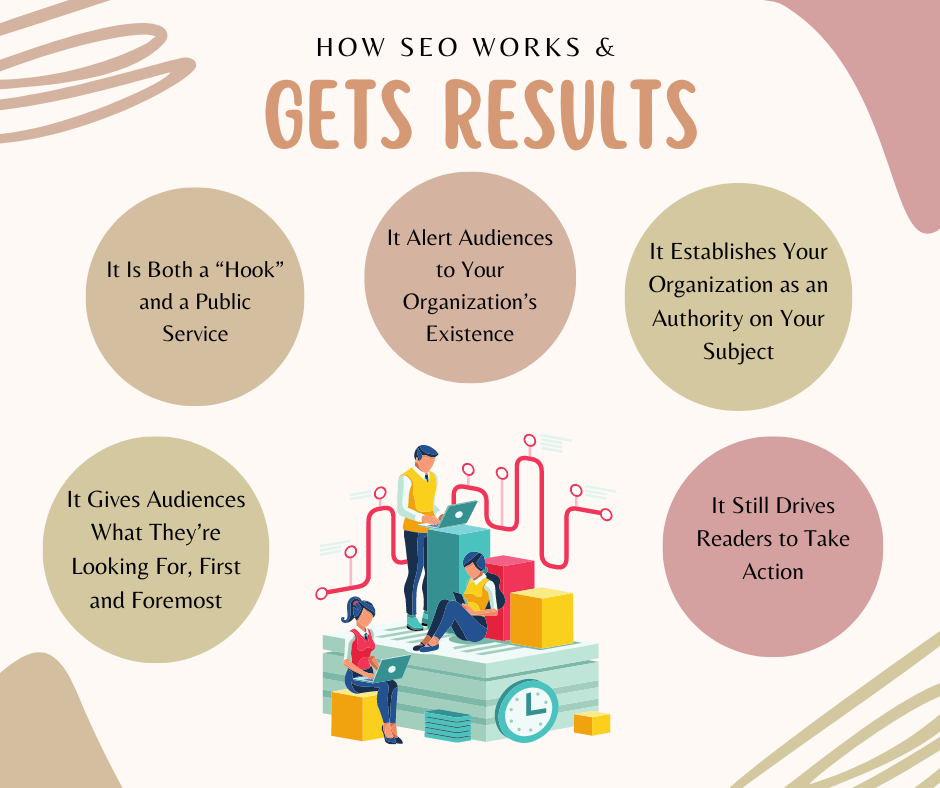SEO Content vs. Newsletter Content: Getting Results
SEO Content vs. Newsletter Content: Getting Results With Your Nonprofit Blog
We all have that one parent or relative who sends seemingly random text messages without necessary context, or who verbally launches into the middle of a detailed story in which a) key “introduction” information is missing, or b) we’re not interested because we’re not really the best target audience for it. Either way, this makes for an awkward and unrewarding one-way interaction that many of us try to (tactfully) escape. But there’s good news: you can help your nonprofit’s blog content get far better results if you keep this kind of encounter in mind.
If your nonprofit has a blog (and it should), you understandably might be tempted to use it primarily as a place to market your organization’s services, tout its achievements, bring visibility to its challenges, and alert readers to important upcoming fundraisers and other events. In fact, this is a common practice among many nonprofits. But there are two major elements of blog writing that can make or break its effectiveness: understanding who your audience is and what kind of content will interest readers where they are in order to motivate them to take action.
If your articles are focused primarily on your organization and its operations, you’re starting at the middle-to-end of your “conversation” with audiences. Don’t worry: there’s a great place for this writing approach. It’s just not your blog.
It’s your newsletter.
As forms of communication, blogs and newsletters can both be highly effective at gaining greater support for your nonprofit. However, they accomplish this in very different ways, and it’s essential to plan the content for each with these disparate goals in mind. That’s because they are, in fact, two different parts of a larger content strategy to get results for your nonprofit.
Here’s the difference between the two—and why SEO content for your blog can not only expand your newsletter audience but boost your organization’s success as a whole.

Newsletter Content vs. SEO Content
In both newsletter and SEO content, keeping your target audience or target market in mind is key. To do this, it helps to clearly define the audience for each and consider where they are in their relationship with your nonprofit.
Your Newsletter
Your newsletter has a very specific purpose, which is, of course, to keep reader-supporters up to date on what’s happening in your organization. It also has an equally specific target audience, which is your existing list of email or hard copy newsletter subscribers.
Your email and “snail mail” subscribers are the target audience you’ve already won over to at least some degree, even if they haven’t yet decided to donate. They know your organization exists, and they’re interested in its updates and internal workings. By sending them news and updates, you’re giving them exactly what they have signed up to receive, which means you can and should continue to do so in full (but coherent) thick-of-the-plot detail.
Your Blog
Unlike your newsletter, your blog content (ideally) appears in results from major search engines like Google. This means that your target blog audience is everyone on the entire internet who cares, or might be persuaded to care, about the particular issues your organization seeks to address. And the majority of internet readers out there don’t even know your nonprofit exists, much less know if they want to sign up for your newsletter—yet.
The purpose of your nonprofit’s blog posts should be to reach as many new readers as possible—and convince them to join the ranks of your existing supporters. In other words, they are strangers, and you want to make a good first impression to win them over (preferably as a poised speaker who complies with accepted conventions for polite conversation).
Content Marketing Strategy Is Like the Donor Journey
If any of this sounds familiar, it’s because a successful nonprofit content marketing strategy is similar to (and integral to) the donor journey you’re already familiar with. Your newsletter content is positioned somewhere in the “research,” “decision,” or “appreciation” portion of the general donor journey map: the middle-to-late point at which your target audience is already aware of and interested in your work. Your blog content, on the other hand, is located at the very beginning of the journey, in the “awareness” portion.
The goal of your blog content should be to get the largest possible audience of internet readers to read your articles and become invested in your organization. First, you’ll need articles that show up in more internet searches so that more readers will be able to find them. For that, you’ll need high-quality search engine optimized (SEO) content.
…And It’s Funnel-Shaped
We’ve established that blog content exists at the beginning of the reader/donor journey, and that it should be search engine optimized so that your articles land on the first page of Google results in relevant searches. Put another way, nonprofit content strategy as a whole works best as a funnel.
Your blog content exists at the top of the tunnel (TOFU), which roughly correlates to the “awareness” stage of the donor journey, or the point at which readers first have an opportunity to learn that your organization exists and what it does. However, your newsletter subscribers are at the level of interest where they:
- Know your organization exists and want to learn more about it (the “research” part of the donor journey)
- Have decided to donate (the “decision” point)
- Have donated and want to see the difference their contribution has made (the “appreciation” point)
This places your newsletter at the middle or end of the donor journey and somewhere in the middle of your content marketing funnel (MOFU) or the bottom of it (BOFU). Newsletter content is located somewhere in the middle or end of your “conversation” with readers as well.

How SEO Content Works and Gets Results for Your Organization
We’ve established that your blog content exists at the beginning of the donor journey, the top of your content marketing funnel, and as the context or “why” for readers’ future interactions with your organization. At this early stage, your blog should offer content that will interest as many readers as possible. If you’re wondering what sorcery works best here, it’s simple: give internet searchers the answers to questions they are Googling. Offer them valuable information on broad, education-oriented topics that intersect with your organization’s mission.
Here’s how well-constructed SEO blog content boosts your readership and supporter base.
It Gives Audiences What They’re Looking For, First and Foremost
General topics related to your mission won’t bring every single internet reader sprinting toward your nonprofit with their wallets open. However, they will reach the largest possible niche audience who shares (or may come to share) your nonprofit’s concerns, and they provide organic, no-pressure reasons to support its mission. Even niche audiences use fairly general terms to search for information on Google. Keeping topics broad helps your content show up in more Google searches—and land in front of more sympathetic readers’ eyes.
It Is Both a “Hook” and a Public Service
By designing your blog topics as the answers to frequently-searched questions rather than news specific to your organization, you’re crafting an effective “hook” for readers. Yet because you’re offering sound information, it’s a more than ethical move. When it’s well-researched and well-presented, your content will indeed offer audiences the essential answers it promises, plus a good deal more besides.
It Alert Audiences to Your Organization’s Existence
When your content is designed to hold audiences’ attention all the way down to the last word, it will motivate people to also read your Call to Action section (CTA) at the end of each blog post. Your CTA is where your readers—most of whom will, again, have come to your article via a Google search, not your website—will first learn that your organization exists. They’ll see how your mission connects to the information they’ve been given. And since they were interested in the topic before they found you, they may want to take the actions suggested in your CTA.
It Establishes Your Organization as an Authority on Your Subject
Offering information that is as credible, objective, and compelling as it is valuable also helps to establish your nonprofit as an authority on all topics related to your work. Google refers to this quality of content as reflecting experience, expertise, authoritativeness, and trustworthiness (EATT).
EATT-style content will not only capture readers’ attention, but build your nonprofit’s credibility in their minds as they work their way through your article. The more confident readers are in the insights your content offers, the more faith they will put in your organization by association.

It Still Drives Readers to Take Action
The trust you’ve built with high-quality, widely relevant content can lead readers not only to click on the internal links in your CTA, but check out your social media pages and other parts of your website. The more time new audiences spend engaging with your content, the more likely they will be to take action in the ways you want them to: subscribing to your newsletter, volunteering, donating, sharing your posts on social media, and more.
When you design your content with general audiences in mind, you’ll get more people interested in learning about your organization, what it does, the “big picture” of why your work matters, and how they can support your mission. This brings you a big step closer to having an audience who will be motivated to sign up for your newsletter—or whatever other priorities your nonprofit may have.
In short, SEO blog content offers a polite and logical introduction that works well for interesting readers in having a deeper conversation with your organization. It also presents your nonprofit as a reliable teacher readers will want to consult and support rather than a rambling relative who’s trapped them in a self-absorbed monologue.
If you’d like your blog content to start showing up in internet searches and start drawing in readers, but don’t have experienced SEO bloggers on staff, Nonprofit Megaphone can help! As a Google premier partner, we’ve helped hundreds of nonprofits draw traffic to their websites and increase clicks and conversions through our expert content. Our writers are trained not only in writing high-quality blog articles tailored to your organization’s voice, but in keyword research and best practices for SEO in general and Google in particular.
Contact us today for a free consultation and the opportunity to explore our wide variety of content plan options. Check out our case studies to learn more about our services, including Google Grant Management, Facebook fundraisers, and content creation.
The post SEO Content vs. Newsletter Content: Getting Results appeared first on Nonprofit Hub.









Leave a Reply